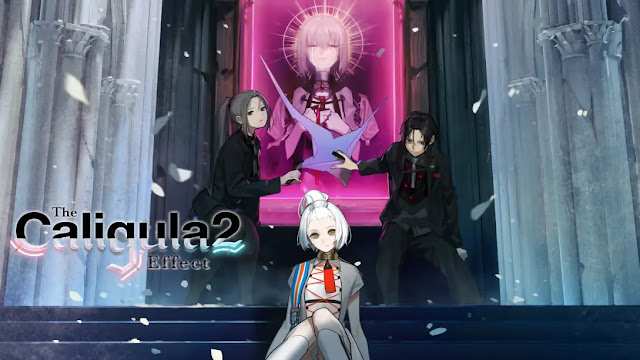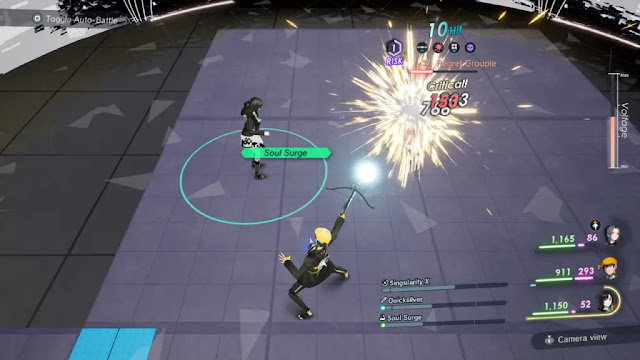Caligula
Effect 2 by developer FURYU corporation and publisher NIS America Inc.—Sony PlayStation 4 review by Richard with a
copy provided by publisher.
Estimated reading time: 8 minutes
What do you call the guilt and excitement that comes from doing something you shouldn't do? That would be The Caligula Effect. I had the wonderful opportunity to review the Caligula Effect Overdose a while ago, and now there comes the sequel: Caligula Effect 2. With some time and feedback to improve the title, let's take a look at what has been updated and improved, or what should have been improved.
In Caligula Effect 2, you take on the role of a protagonist you choose the name and gender of. Upon awakening in the World of Redo, you come to the realization that the world is artificial, created by a Virtuadoll named Regret. Together with the Virtuadoll χ (pronounced 'key'), who enlists you to help her tear down the world of Redo to let those captured out. Yes, this is also the plot of the first game, but there are a few differences. First up, χ is the "daughter" of Mu from the first game, and the new world is based on regrets instead of mental traumas or conditions.
This has a few notable impacts, most of which I personally found rather disappointing, but may be better received by the audience. The goal of χ isn't any sort of noble escapade, but rather that Mu, her mother, is being blamed for creating another virtual world and mass coma incident. As for the characters, regrets cover a rather wide array of possibilities, from regretting causing someone's death, to regretting not taking care of your appearance, or even not getting in on a fad earlier. This results in a lot of the NPCs feeling a little…less impactful than in the first title, albeit a whole lot less sketchy as a whole.
In terms of gameplay and combat, Caligula Effect 2 has been refined a lot, but feels a little lacking still in some other areas. Very similar to the first title, you can roam around areas you have unlocked, getting into combat with the NPCs that have been corroded, or miscellaneous enemies that are trying to take out their stress and aggression on you. A quick note: your running animation looks dumb. You can also go around and kick these crystals for χ-jack gauge as well as possible items, pick up chests, and talk to the NPCs in order to take on their quests, resolve them, and fill in their profiles with what their regrets are and some more personal info on them, as well as items and potentially improving the main characters status.
Unlike in the first title, the number and…aggravating-ness of the side-quests has been significantly toned down. Side-quests can be separated into two categories: group and solo. Group quests are chains of objectives that are part of a mini self contained story, normally consisting of 5 or 6 parts, that will generally require you to either go talk to someone, or to have a specific piece of equipment or passive skill, which I'll comment on later, and are generally pretty straightforward, especially since most of the equipment is easily obtained from chests or other quests. Solo quests are individual quests that are one and done, and have a wider array of possibilities, such as retrieving certain items, beating certain tough enemies, meeting certain battle benchmarks, or even just talking to them for a bit.
The story progression is also similar to the first game, as the world of Redo is being controlled by musicians, who essentially brainwash the inhabitants in order to keep them believing that the world of Redo is actually real. You will learn a bit about the musician that's next on your hitlist, visit a new area and work your way through, and then beat up the musician in charge of that area. Afterwards, you are free to explore the area at your leisure, completing side quests and doing some training. Yes, the game is a JRPG similar to its predecessor, where you can build exp to level and party member affection in battle. Outside of battle, you can talk to other party members in order to learn about them through their specific character quests.
Now, if you've played the previous game, you may be wondering about how the combat works. Well, it's fairly similar, but it does feel more refined. You can bring up to four party members into battle with you, and are able to select attack, support, action moves, or items. Once you select a move, there is a wait time before the move starts, then the move takes place, then a cooldown period before you can select another move. When you initially select a move, you get to see a prediction for what you teammates and enemies will do, and what will happen to the enemies when you perform your moves. You can adjust your moves to put a delay on the move, which is useful if you wait for an enemy to use a move, and then time your attacks to counter them.
Something you will probably notice is that a lot of the moves you can select have added effects, such as melee counter, ranged counter, or guard break. These will take effect as long as an enemy is preparing a move, so this is when you want to put a delay on your moves, as well as the guard, which will block damage and status effects. The combat system feels a lot less intense than the first game, and is a lot less complicated, at the expense of a little customizability.
Keep in mind though that the future prediction doesn't account for missed or critical hits, meaning that you could get flinched out of an attack, or miss flinching an enemy out of an attack. During combat, you also have two gauges that will build up: a personal super move per character, and a χ-jack gauge. The personal super move should be self explanatory, but the χ-jack will start playing a χ based song of your choice, which will provide bonuses, such as reduced wait times between attacks or improved defense while the song is playing.
An interesting function of the game is how equipment functions. While equipment does raise your stats as equipment normally should, the accessories, and character specific weapons, will have passive skills added to them, which you can learn by earning a set amount of points during battle. The passive skills can then be equipped even if you remove the equipment, and you can equip up to six of them. These passive skills are also used in certain quests in order to complete them.
One thing I really enjoy about the combat system is the ability to toggle between fully automatic teammates or allowing you to choose their moves for them. While they won't guard, at least from what I've seen, they tend to be rather smart, and will generally perform a scenario specific attack or counter when acting on their own. On the other hand, with full command over them, you can fight enemies much higher than your level, simply by staggering counters in order to keep them from attacking you.
While that's the main meat of the gameplay, let's talk about a few other things. The game is musically inclined, and while I enjoyed the majority of the tracks, and I love how there isn't any interruption and restart of the tracks, and the transition to vocals when entering into battle, I did find that χ makes a rather…unfortunate singer. I much preferred most of the Regret based tracks to the χ based tracks, unfortunately. The graphics are a little lacking for a PS4 title, looking closer to something that would be on the PS3 or something.
The artwork for the rest of the game is good, it's just the character models that are a little lacking. Also, there is a lottery type thing you can enter with tickets. It's right beside the convenience store. Yes, I'm telling you this because it isn't well shown, and I only found it much later than I should have. Another nice point is that completing the character info grid, or causality chart, is significantly easier to complete than the previous title.
Caligula Effect 2 does a lot to refine the system, but also feels like it has a lot less impact than the first title. The combat is a lot less overwhelming, and there is a much better pace, the side quests aren't migraine inducing, and the game just feels as if it flows a lot better. On the other hand, since this world is based on regrets instead of trauma, the characters tend to have significantly less impact than they did in the first title. That being said, all the characters have their own unique personalities and playstyles, making swapping between characters more feasible than other games with a large cast of characters.
Summary
Overall, I had a lot of fun playing through Caligula Effect 2, and those who felt squeamish with some of the content in the first may feel better with the second. Caligula Effect, both 1 and 2, are pretty unique games, and I highly suggest looking into either or both of them, as they are both really fun titles.
Score: 8.5 / 10




















0 comments:
Post a Comment